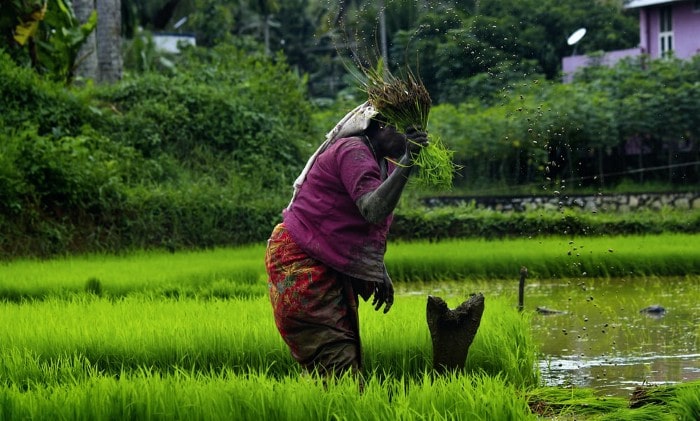
Free our farmers. They can help us absorb the impact on COVID- 19. Freeing here means remove the bottlenecks in their supply chain. Yes. The same ‘supply chain’ which the Prime Minister mentioned 9 times in his speech on 12th May. Following it, Finance Minister announced the creation of ‘Rs 1 lakh crore Agri-Infrastructure Fund for farm-gate infrastructure’ and a ‘legal framework’ to amend the Essential Commodities Act and APMC Act. On paper, these are bold steps in the right direction, but in the context of the pandemic, this shall do nothing to alleviate the immediate pain of the farmers.
The present government’s record in reviving the agriculture sector does not instill any confidence. India’s Average Agricultural GDP growth in the period 2004–5 to 2013–14 is 4%. This has plunged to 2.9% from 2014–15 to 2018–19.
Agriculture is the largest private sector but the Government has not let it unshackle its true potential due to enormous controls. This tendency to control agriculture stems through two historical reasons. First, until the Green Revolution made us self-sufficient in grains, India was dependent on foodgrain hand-outs by developed countries. Our farmers battle all kinds of challenges, including drought and monsoon and show a record increase in the food grain production, each year. For cereals, the Minimum Support Price (MSP) is a committed liability of the government to assure the farmers of a remunerative and stable price environment in the “increasing of agricultural production and productivity”.
Second, Remunerative prices to farmers in the political economy of India became an important issue after the 1960s as big farmers became an important political interest group. Farmers used this newfound political power as a tool to seek higher and more stable farm prices through government intervention which made India the second largest food producer in the world. Thus, shedding years of ignominy which India suffered through foodgrain import. Record food production is a matter of pride for us because it comes with a piece of historical baggage. It is the first item which is reflected by the government in any agriculture report.
From the farm to the dinner table, the government virtually controls every aspect of the agriculture sector. There is ‘Capital Control’ in the form of restrictive ownership, lease and tenancy laws. It is virtually impossible for a farmer to sell or rent her land to private people. There is ‘Input Control’ in the form of government regulating the prices of fertilizers, seeds, subsidy on water and power. The GST on farm equipment and allied parts is also a kind of control. Then, there is ‘Price and Trade Control’. The Essential Commodities Act regulates the price of farm produce. The APMC Act facilitates on a broken market system which is monopolistic and rent-seeking, with high commissions, especially for perishables. There are massive trade barriers which impede free trade of India’s farmers with the rest of the world.
Many experts and policymakers who are grounded to the cause of farmers do believe that the opening up of Indian agriculture needs to be gradual and incremental. After all, the sector affects the economic well-being of half the Indian population and provides access to affordable and nutritious food for all Indians. There is a need for a much-balanced approach than just some one-time magic pill of deregulation.
Finance Minister’s announcements are neither sound incremental policy measures to free the farmers nor any reforms by stealth. They are just lip-service, wrapped into a ‘package’ — meant for headlines management.
Several reasons. Agriculture is a State subject. At most the Union can make a ‘Model Law’ for states to adopt. But it is up to the states to adopt it. The Union did this when it passed the ‘Liberalizing Land Lease Markets and implementation of Model Agricultural land Lease Act, 2016’. Very few states, even from the ruling party adopted it. So the measure of removing ‘Capital Control’ was not successful.
Marketing of Agricultural commodities is again a State subject. While announcing that the “Centre will frame a law for adequate choices to a farmer to sell produce at attractive price” and remove the “barriers of free interstate trade”, the Finance Minister failed to emphasize that this will be at best, only a model law for states to adopt. Just like the Land Lease Act.
A second option for the Union would be to take refuge in the ‘Concurrent List’ items which has trade of ‘food stuffs’, ‘raw cotton’, ‘raw jute’ and ‘cattle fodder’ listed in it. For that yet another law needs to be passed using article 301 of the Constitution.
Finance Minister announced that a “facilitative legal framework will be created to enable farmers for engaging with processors, aggregators, large retailers, exporters etc.” On paper, very good. But it is a broad policy announcement with no details, roadmap or institutional framework.
Amidst the pandemic, the Parliament or its Standing Committees are not functioning even through video conference. There is no legislative oversight. No bill has been put forth for public consultation. Bringing ordinances will not serve any purpose here. The government should bring in the entire legal framework in the Monsoon Session of the Parliament. This would not be enough without consulting the states. A knee jerk, policy push without an institutional framework would only end up like the flawed GST regime.
Partial removal of ‘Price & Trade Control’ is only a half-baked measure. An entire architecture of deregulating agriculture needs to be created, with the simultaneous removal of ‘Input Control’ and ‘Capital Control’. This needs huge planning and institutional setup. The e-NAM mandis brought by this government failed because of a lack of planning on the logistical side.
In the COVID-19 crisis, when the economy has become more inward-looking and our farmers need money in their hands for input costs, freeing them partially without adequate support would be a travesty. It is best to first provide them with monetary support and then to usher in these reforms, after creating an institutional framework.



RECENT COMMENTS